Which gutter liner should you use?
Industrial steel gutters on metal or asbestos roofs are not easy to replace and therefore, when they become problematic, the usual action is to install a gutter liner. But which type is best for the professional specifier?
It really comes down to personal preference, because there are several types of industrial gutter liner available in the UK;
Single-Ply Gutter Liner
This is a flexible reinforced material, supplied on a continuous roll, that is laid into the gutter and pushed into position, and held in the gutter by secret fixings.
If any joints are required, these are welded at the time of installation. Gutter outlets are simply cut out of the material and a pre-formed outlet is then dropped into the rainwater pipe and heat-welded into position using a hand-held welding tool.
Advantages:
- Can be quite inexpensive.
- Relatively easy to install.
- Quick to install.
Disadvantages:
- Welds can fail or be incorrectly installed, leading to leaks which can be difficult to locate.
- Single ply gutter membranes are extremely susceptible to mechanical damage from foot traffic.
- Repairs will always require welding due to the nature of the material.
- Difficult to install when space is limited, for example in narrow valley gutters.
- Existing gutter fixings usually have to be sheared off to help prevent accidental penetration of the membrane.
- Short term life expectancy of around 10 years.
Steel / PVC Hybrid Gutter Liner
Similar to the single ply gutter, but with the advantage of a steel base to which the single ply membrane is welded to. The gutter liner comes in 3 metre lengths with 75mm over-lapping membrane that is welded during installation to provide a water-tight joint.
Advantages:
- Easy to transport, because it is manufactured in section lengths of up to 3 metres.
- Quick to install, because it folds into the gutter before being fixed into position.
- Sits flat in the gutter, reducing the chance of ponding water.
- Fast lead times from point of order.
Disadvantages:
- Sections require welding, which increases the potential weak spots due to insufficient welding.
- Outlet details reduce the original outlet diameter and this can adversely affect water flow.
- Existing gutter fixings have to be sheared off, but will still remain proud of the gutter and could create unforeseen problems.
- Very tricky to install in complex gutters, because of the flat, straight sections.
- Trafficking is possible, but can cause damage to the gutter liner.
- Existing gutter continues to deteriorate beneath the new liner.
Thermoplastic Gutter Liner
A physical gutter liner that can be custom-made and ready-creased to fit the gutter profile it is being installed into, making it quite easy to install. The liner is usually supplied in a roll, with outlets already engineered in. Once installed, the liner sits on top of the original gutter and is held in place with a combination of screw fixings, special liner clips and retainer plates.
Advantages:
- Manufactured to fit the gutter, so less chance of installation error.
- Stronger than single-ply systems and wider gutters can be trafficked.
- Largely seamless, which reduces the risk of leaks.
- Custom formed details and outlets available, reducing the chance of installation error.
- Very long life expectancy in most cases.
Disadvantages:
- Expensive due to requirement for accurate measuring and custom manufacture.
- Heavy, so requires careful handling on larger runs of gutter.
- Existing gutter substrate continues to deteriorate beneath the new gutter liner.
- Expands and contracts depending on temperature, resulting in significant ponding.
- Gutter joints and outlets can be vulnerable.
- Existing gutter fixings have to be sheared off.
- Detailing can be difficult.
Gutterseal Liquid Gutter Liner
Applied directly to the cleaned and prepared gutter to form a seamless gutter lining that eliminates leaks and the possibility of leaks from the gutter.
Advantages of Gutterseal:
- Seamless, so there should be no vulnerable areas.
- Fully bonded to the substrate and on metal gutters, the substrate is protected by an anti-corrosion coating.
- Extremely flexible, so the liquid gutter liner is unaffected by temperature fluctuations.
- Can be installed in the most complicated shaped gutters and in confined spaces, for example, in tight valley gutters.
- Can be installed on a wider variety of gutter substrates, including asbestos cement, concrete, cast iron and galvanised steel.
- 100% UV stable
- Easy to repair if damaged just -overcoat affected area.
- Can be completed at the same time as a cut edge corrosion treatment or full roof coating.
Disadvantages of the Gutterseal liquid gutter liner:
- Weather-dependent installation means that gutters often require thorough drying before installation.
- Can be damaged by high pressure jet washing and rodding, so care must be taken when cleaning the gutter.
- Existing coatings / repaired must be removed before the Gutterseal system can be installed.
Conclusion
There is a lot to consider when choosing which type of product to use as each system has its own pros and cons.
At Liquasil, we are happy to tell you if a liquid gutter liner might not be suitable for a particular installation.
Our building surveyors will be happy to talk you through the options available to you and will even suggest an alternative if we feel that our liquid gutter liner is not suitable.


